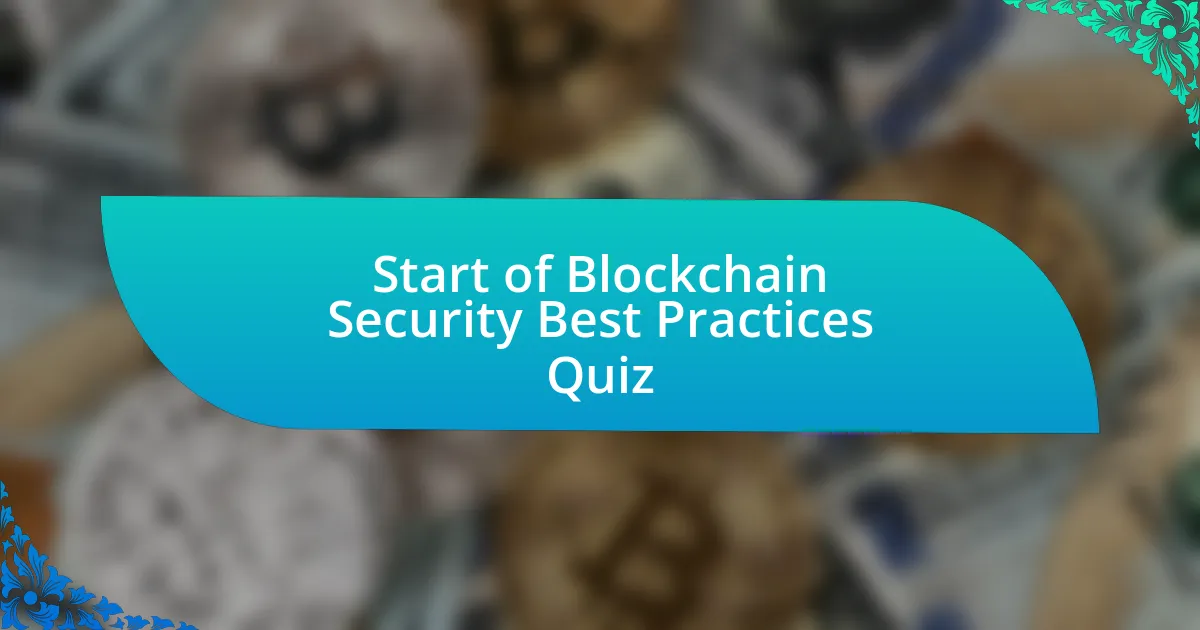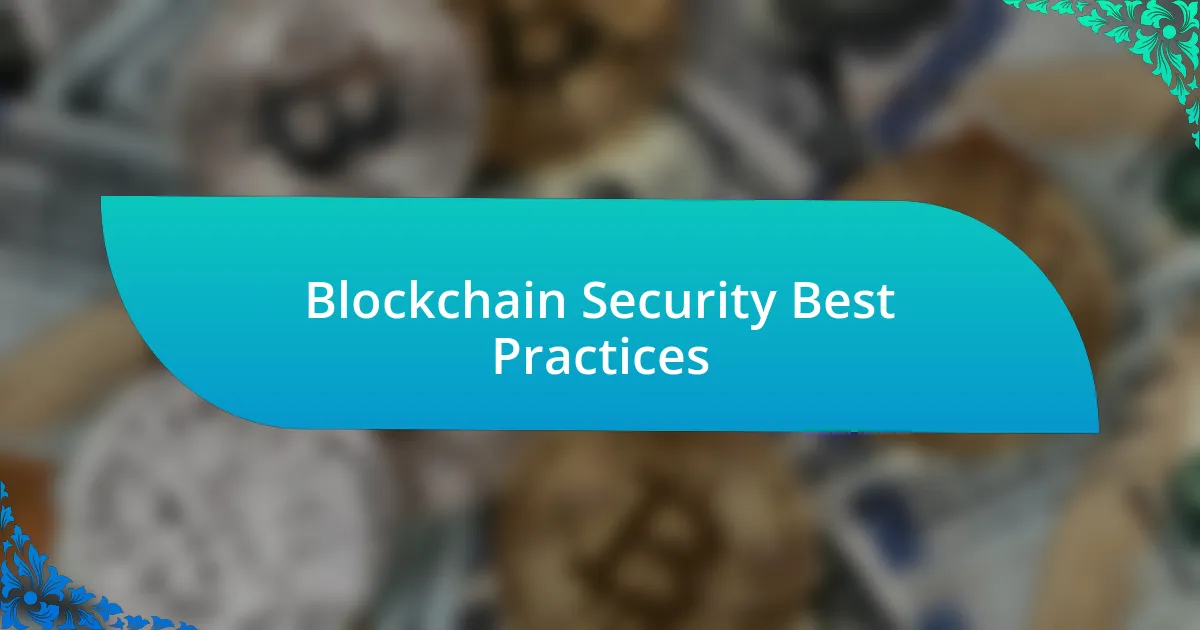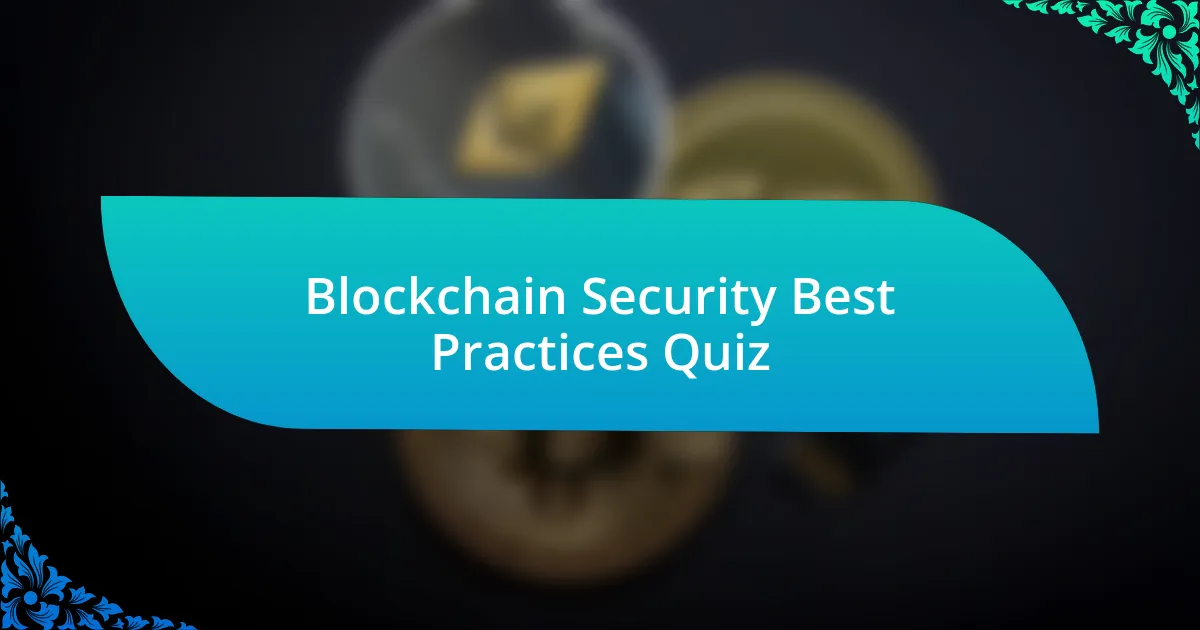
Start of Blockchain Security Best Practices Quiz
1. What is the primary purpose of encryption in Ethereum blockchain security?
- To allow unrestricted access to all network participants.
- To enable anonymous transactions for users.
- To increase transaction speed and reduce costs.
- To ensure the integrity and confidentiality of blockchain transactions and data.
2. Which encryption standard is most commonly recommended for Ethereum blockchain applications?
- RSA-2048
- AES-256
- Blowfish-64
- DES-128
3. Why is encrypting private keys essential in Ethereum development?
- To enhance transaction speeds and lower costs.
- To verify user identities and permissions effectively.
- To simplify the management of blockchain contracts.
- To protect access to and changes in blockchain network nodes.
4. How does Identity and Access Management (IAM) contribute to Ethereum blockchain security?
- To encrypt all data on the blockchain for added privacy.
- To control access to the blockchain network and prevent insider attacks.
- To verify the identity of miners before transaction approval.
- To ensure all transactions are anonymous and untraceable.
5. What role does multi-factor authentication (MFA) play in securing Ethereum transactions?
- MFA solely relies on usernames and passwords for access.
- MFA enhances transaction security by requiring multiple verification methods.
- MFA accelerates transaction processing speed significantly.
- MFA eliminates the need for any password protection at all.
6. What is the function of multi-signature wallets in Ethereum transactions?
- To store cryptocurrency securely in cold wallets.
- To authorize transactions without any digital signatures.
- To eliminate the need for public keys in transactions.
- To verify user requests and prevent attacks like Sybil or 51% attacks.
7. How can a 51% attack affect the Ethereum blockchain network?
- It can make the blockchain completely private and untraceable.
- It can cause all nodes in the network to be deleted.
- It can allow an attacker to manipulate transactions and double-spend coins.
- It can prevent all transactions from being processed forever.
8. What distinguishes a public Ethereum blockchain from a private one?
- Private blockchains allow anyone to participate and validate transactions.
- Public blockchains restrict access to selected participants only.
- Public blockchains allow anyone to participate and validate transactions.
- Private blockchains have fewer validators than public ones.
9. How does immutability benefit the security of Ethereum transactions?
- It allows faster processing of transactions.
- It enables anonymous transactions for all users.
- It ensures that transaction records cannot be altered.
- It reduces the energy consumption of the network.
10. In the Ethereum network, what responsibilities do nodes have?
- A node exclusively engages in trading activities for network participants.
- A node validates transactions, stores the blockchain, and communicates with other nodes.
- A node sends cryptocurrency to users and monitors their transactions.
- A node manages the mining process and creates new blocks in the network.
11. How are public and private keys utilized in Ethereum cryptography?
- Private keys are for verifying identity while public keys are for signing.
- Public keys are used for validation whereas private keys encrypt data.
- Public keys encrypt transaction data while private keys allow access.
- Private keys encrypt data while public keys allow transaction access.
12. Why are robust passwords critical for Ethereum blockchain security?
- To allow easy access to personal information for developers.
- To ensure reliable transaction speeds and scalability in networks.
- To guarantee high levels of data transparency and trust.
- To prevent unauthorized access and protect against phishing and social engineering attacks.
13. What is the significance of secure key management in Ethereum applications?
- To increase the transparency of blockchain data and operations.
- To promote decentralized decision-making among network participants.
- To enhance transaction speeds and reduce latency in the network.
- To safeguard private keys and prevent breaches by using secure storage solutions like hardware security modules (HSMs).
14. How can key rotation protocols improve Ethereum security?
- By permanently storing all access keys in a single database.
- By sharing keys openly within the network.
- By regularly rotating private keys to decrease the risk of compromise.
- By generating new keys without any verification processes.
15. What advantages does Multi-party Computation (MPC) offer in Ethereum security?
- It enhances security by distributing key management responsibilities among multiple parties.
- It centralizes control to reduce management complexity.
- It eliminates the need for encryption in transactions.
- It limits access to privileged users only for efficiency.
16. Why is continuous monitoring critical for Ethereum blockchain networks?
- To facilitate anonymous transactions and enhance privacy.
- To reduce the data storage requirements of the blockchain.
- To continuously identify and respond to suspicious activities and potential threats.
- To improve the speed of blockchain transactions and confirmations.
17. How does user education enhance security measures in Ethereum development?
- To reduce transaction times and increase network efficiency.
- To equip users with knowledge on blockchain security best practices, making them less susceptible to phishing and social engineering tactics.
- To improve the graphical user interface of Ethereum applications.
- To enable the use of smart contracts in decentralized applications.
18. What effect does regulatory compliance have on Ethereum blockchain security?
- By allowing any entity to access blockchain data freely.
- By enabling unlimited data storage without standards.
- By removing all security protocols from blockchain systems.
- By ensuring that blockchain applications align with applicable laws and industry standards.
19. How does incident response planning help Ethereum developers address security breaches?
- To establish strict coding guidelines and protocols for developers.
- To prepare for unexpected security incidents and minimize potential damage through swift and decisive action.
- To create a detailed user manual for blockchain applications.
- To enhance the user interface of decentralized applications.
20. Why is secure coding important in Ethereum application security?
- To optimize the performance and speed of Ethereum transactions and interactions.
- To enable decentralized governance and decision-making within the Ethereum network.
- To improve the aesthetic design of smart contracts and user interfaces in Ethereum apps.
- To ensure the security of apps, contracts, and algorithms by fostering a culture of security awareness and minimizing the likelihood of introducing vulnerabilities.
21. What practices ensure the security of Ethereum smart contracts during development?
- Automatic deployment without checks
- Ignoring best practices
- Secure development practices
- Regular downtime testing
22. How do Merkle trees improve transaction verifiability in Ethereum?
- By helping users verify the possibility of including a transaction in a block through repeated hashing of node pairs.
- By simplifying smart contract execution for faster transactions.
- By removing the requirement for public and private keys in transactions.
- By eliminating the need for miners to process transactions.
23. What role does node security play in maintaining the integrity of the Ethereum network?
- To establish a single point of control for network operations.
- To limit the number of transactions processed per second.
- To prevent all forms of external access and collaboration.
- To fortify individual nodes within the network by keeping software updated, using robust passwords, and implementing stringent access controls.
24. Why should Ethereum developers adopt a zero-trust security model?
- To simplify user access and authentication processes.
- To ensure that no entity is trusted and all interactions are verified.
- To allow for more efficient transaction processing speeds.
- To enhance the visual appeal of blockchain interfaces.
25. How do regular security assessments benefit Ethereum applications?
- To uncover potential vulnerabilities and fortify the applications against emerging threats.
- To reduce transaction fees and enhance user experience.
- To increase transaction speeds and improve network efficiency.
- To validate token transfers and ensure correct balances.
26. In what way do digital signatures provide security in Ethereum transactions?
- By providing non-repudiation and authentication.
- By enabling faster transactions and lower fees.
- By increasing the data storage capacity of the blockchain.
- By simplifying the coding of smart contracts.
27. Why is it important to implement secure key stretching techniques in Ethereum?
- To reduce the cost of running blockchain applications significantly.
- To ensure all transactions are made completely anonymous.
- To facilitate faster transaction processing on the network.
- To increase entropy and make private keys more resistant to brute-force attacks.
28. What practices safeguard private keys in Ethereum blockchain applications?
- Simplified access protocols
- Centralized control systems
- Secure key management practices
- Regular software updates
29. How does Multi-party Computation (MPC) enhance security in Ethereum environments?
- To distribute key generation and management, eliminating single points of control and enhancing security.
- To mandate all computations to occur on a single server for speed.
- To centralize control and access for easier management of keys.
- To restrict access to only a few trusted participants in the network.
30. What benefits do robust encryption algorithms offer to Ethereum developers?
- By increasing the speed of all blockchain transactions.
- By ensuring the integrity and confidentiality of blockchain transactions and data.
- By allowing unlimited access to all network nodes.
- By simplifying complex coding processes for developers.

Quiz Successfully Completed!
Congratulations on completing the quiz on Blockchain Security Best Practices! You have taken an important step toward understanding the crucial principles of securing blockchain technology. This quiz likely helped you identify key concepts such as encryption techniques, smart contract vulnerabilities, and the importance of consensus protocols. Each question guided you through the fundamental aspects of blockchain security, enhancing your overall comprehension of the topic.
As you navigated through the quiz, you may have discovered new strategies to protect your blockchain applications. Learning about best practices is essential, especially in an era where cyber threats are ever-evolving. Your engagement with the material showcases a commitment to becoming more knowledgeable and prepared in the field of blockchain security.
We invite you to explore the next section on this page for deeper insights into Blockchain Security Best Practices. This resource will expand on what you have learned and provide you with comprehensive information to further enhance your understanding. Delve into the world of blockchain security and empower yourself with the latest tools and knowledge to safeguard your digital assets.

Blockchain Security Best Practices
Understanding Blockchain Security
Blockchain security refers to the measures and techniques used to protect the integrity, confidentiality, and availability of blockchain networks. It encompasses the protocols and mechanisms that prevent attacks, data breaches, and unauthorized access. Key aspects include cryptographic techniques, consensus algorithms, and overall network design that foster resilience against malicious actions.
Key Threats to Blockchain Security
Blockchain systems face various threats, including 51% attacks, Sybil attacks, and smart contract vulnerabilities. A 51% attack occurs when a single entity controls more than half of the network’s hash rate, enabling them to manipulate transaction verification. Sybil attacks involve creating multiple identities to gain control over the network. Smart contract vulnerabilities arise from coding errors or logic flaws that can be exploited by attackers.
Best Practices for Key Management
Effective key management is vital for blockchain security. Users should employ hardware wallets, which store private keys offline, minimizing exposure to online threats. Implementing multi-signature wallets adds another layer of security by requiring multiple private keys for transaction approval. Regularly updating and backing up keys further safeguards against loss or theft.
Implementing Secure Smart Contracts
Creating secure smart contracts involves rigorous testing and code auditing. Developers should adopt standardized templates and utilize well-known frameworks to reduce vulnerabilities. Employing formal verification techniques can mathematically prove that the contract behaves as intended under all conditions. Furthermore, continuous monitoring and updating of deployed contracts helps mitigate potential risks over time.
Regular Security Audits and Updates
Regular security audits are essential to maintain blockchain integrity. These audits should include code reviews, network assessments, and penetration testing to identify vulnerabilities. Additionally, keeping the software updated with the latest security patches protects against newly discovered threats. Organizations should establish a schedule for audits and updates to ensure ongoing security compliance.
What are Blockchain Security Best Practices?
Blockchain security best practices are guidelines and strategies aimed at safeguarding blockchain networks from attacks and vulnerabilities. These practices include implementing strong cryptography, conducting regular security audits, and ensuring secure key management. According to a study by Deloitte, organizations that adopt these practices significantly reduce the risk of breaches and enhance overall security posture.
How can organizations ensure Blockchain Security?
Organizations can ensure blockchain security by utilizing multi-signature wallets, conducting penetration testing, and maintaining strict access controls. Multi-signature wallets require multiple private keys to authorize transactions, reducing the risk of a single point of failure. According to the National Institute of Standards and Technology (NIST), these measures significantly mitigate security threats.
Where should blockchain nodes be located for optimal security?
Blockchain nodes should be distributed across multiple geographic locations to reduce risks associated with physical attacks and natural disasters. A diversified node placement strategy enhances redundancy and ensures network resilience. Research shows that decentralization of nodes contributes to improved data integrity and reduced susceptibility to hacks.
When should security audits be conducted on blockchain systems?
Security audits should be conducted both before the launch of a blockchain system and regularly thereafter. Initial audits identify vulnerabilities that need to be addressed prior to deployment. Ongoing audits are crucial as they ensure that new threats are mitigated effectively. A report by the Blockchain Security Consortium emphasizes the importance of periodic assessments in maintaining security effectiveness.
Who is responsible for maintaining Blockchain Security?
The responsibility of maintaining blockchain security typically falls to a combination of developers, security teams, and network participants. Developers implement secure code practices, while security teams conduct audits and vulnerability assessments. Active participation from all stakeholders is vital for a robust security framework, as highlighted by the International Journal of Information Security.

